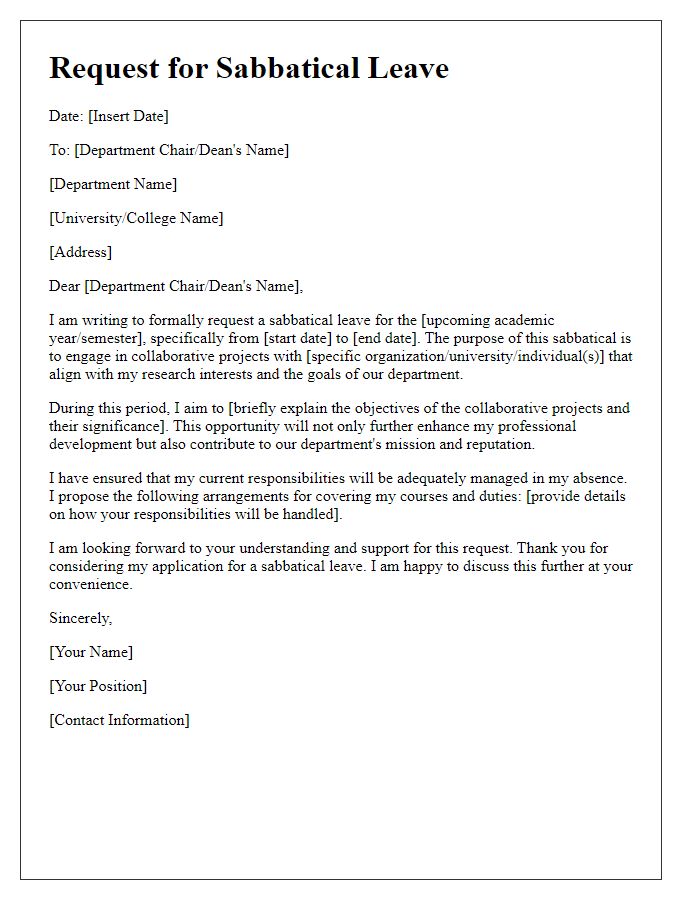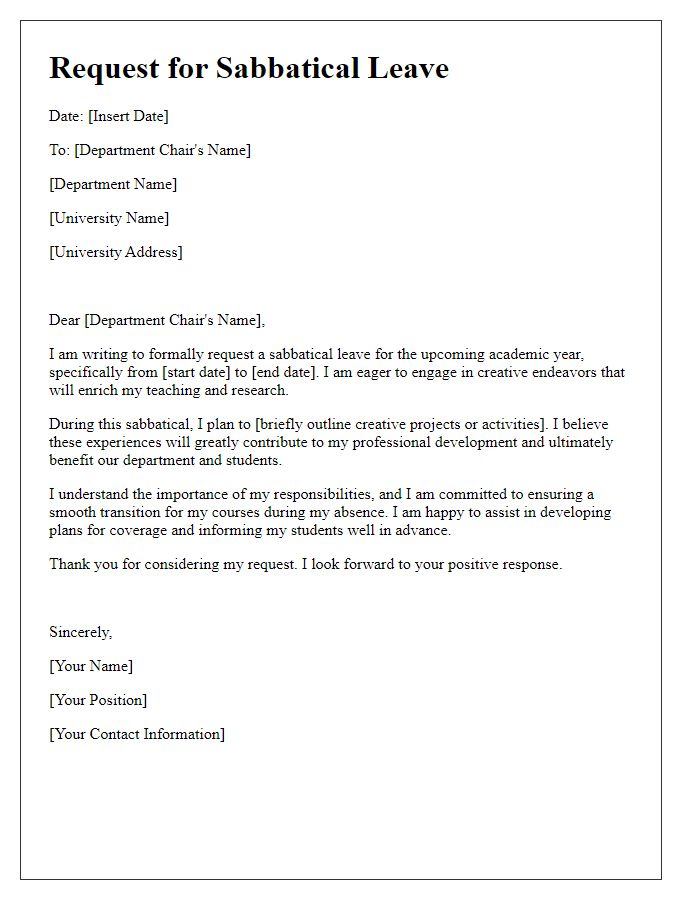Are you considering taking a sabbatical leave to recharge and explore new academic opportunities? Requesting a faculty sabbatical is an important step that allows you to focus on research, professional development, or personal projects that can ultimately benefit your institution. In crafting your request, it's essential to articulate your goals and the value your time away will bring to both your career and your department. So, if you're ready to dive into the process and learn how to structure your leave request, read on for a comprehensive guide!

Recipient Information
Sabbatical leave allows faculty members to engage in scholarly research, professional development, or other activities that contribute to their academic growth. When drafting a request for sabbatical leave, clearly state the purpose and duration of the leave, and outline any significant research projects or publications planned during this period. Include desired start and end dates, specific objectives, and how the sabbatical will benefit both personal academic endeavors and the institution. Emphasize previous contributions to the faculty and highlight any courses or responsibilities that will be managed in your absence, ensuring that academic standards remain uninterrupted. Moreover, address any compliance with institutional policies regarding sabbaticals, such as eligibility criteria, application processes, and any financial implications from the leave.
Purpose and Objectives
A faculty sabbatical leave serves as a crucial period for academic professionals to engage in research, develop new skills, and rejuvenate their teaching methodologies. This leave, often lasting for a full academic semester or an entire academic year, allows faculty members to immerse themselves in their specialized fields, leading to significant contributions in both scholarship and pedagogy. Objectives may include conducting groundbreaking research projects within renowned institutions, attending workshops or conferences for professional development, collaborating with other scholars globally, or writing academic publications that enhance the body of knowledge in their respective disciplines. Overall, a well-planned sabbatical enriches the academic community, fosters innovation, and ultimately benefits students through enhanced expertise and revitalized teaching approaches.
Duration and Timeline
A faculty sabbatical leave offers educators an opportunity to rejuvenate their academic focus and pursue research or professional development away from their teaching duties. The duration typically lasts six months to one year, depending on the institution's policy and faculty member's request. Planning for the timeline is crucial, often beginning with a proposal submission at least six months before the intended sabbatical start date. This preparation phase includes outlining specific goals, anticipated outcomes, and potential impacts on students and the department. Scheduling should consider academic calendars, ensuring minimal disruption to course offerings and student engagement during the absence. Institutions, such as universities with established sabbatical programs, may require detailed documentation, approval from department heads, and presentations regarding the sabbatical's benefits upon return.
Proposed Activities and Benefits
A faculty sabbatical leave allows educators to engage in professional development and research that can enhance their teaching effectiveness and contribute to academic growth. Proposed activities during this sabbatical might include research projects focused on innovative teaching methodologies, collaboration with experts in the field, or developing new courses based on current educational trends. These activities can provide benefits such as enriched curriculum content, improved student engagement, and increased research output, ultimately enhancing the university's reputation. Furthermore, by incorporating findings from this sabbatical into classroom instruction, faculty can provide students with cutting-edge knowledge and skills relevant to their future careers. Engaging in community outreach programs can also foster partnerships between the university and local organizations, creating valuable experiential learning opportunities for students.
Support and Preparations
A well-structured sabbatical leave request can have a lasting impact on academic faculty. Faculty members, such as university professors or lecturers, seeking sabbatical leave often aim for professional development or research opportunities. Support from departmental administration, including deans and department heads, is crucial for the approval process. Preparation for the sabbatical involves outlining specific goals, potential outcomes, and the academic benefits for both the faculty member and the institution. Strategic planning includes identifying funding sources, establishing a timeline, and ensuring course coverage during the absence. Ideally, institutions should foster a supportive environment for sabbaticals to enhance faculty morale and cultivate innovative research contributions.
Letter Template For Request Faculty Sabbatical Leave Samples
Letter template of request for faculty sabbatical leave for research purposes.

Letter template of request for faculty sabbatical leave for personal development.

Letter template of request for faculty sabbatical leave for teaching enhancement.

Letter template of request for faculty sabbatical leave for collaborative projects.

Letter template of request for faculty sabbatical leave for community engagement.

Letter template of request for faculty sabbatical leave for professional networking.

Letter template of request for faculty sabbatical leave for creative endeavors.

Letter template of request for faculty sabbatical leave for academic publication.

Letter template of request for faculty sabbatical leave for health and wellness.





Comments